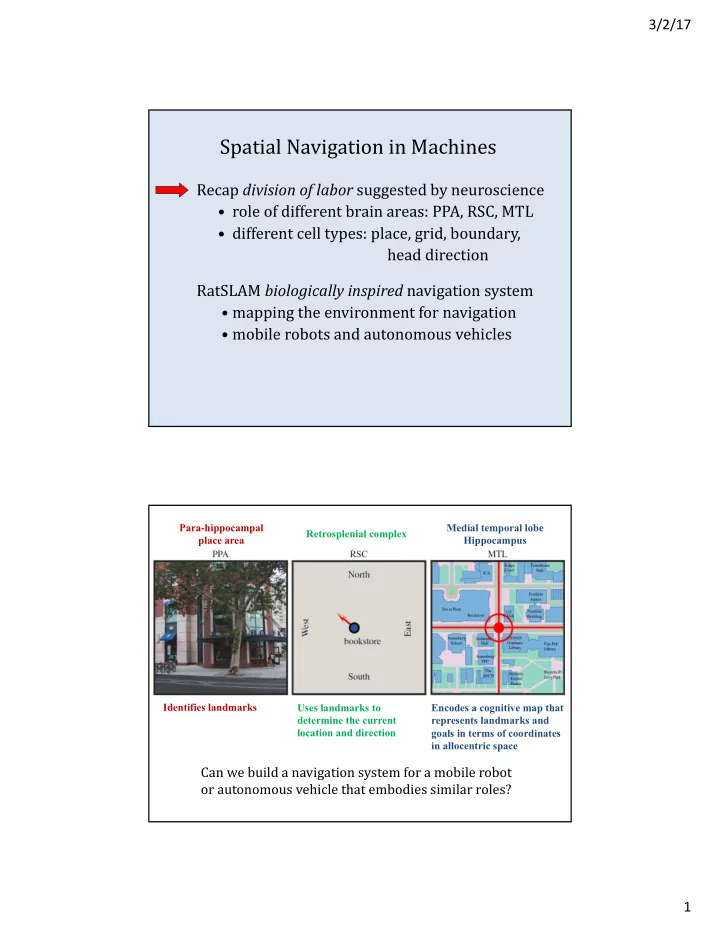

3/2/17 Spatial Navigation in Machines Recap division of labor suggested by neuroscience • role of different brain areas: PPA, RSC, MTL • different cell types: place, grid, boundary, head direction RatSLAM biologically inspired navigation system • mapping the environment for navigation • mobile robots and autonomous vehicles Para-hippocampal Medial temporal lobe Retrosplenial complex place area Hippocampus Identifies landmarks Uses landmarks to Encodes a cognitive map that determine the current represents landmarks and location and direction goals in terms of coordinates in allocentric space Can we build a navigation system for a mobile robot or autonomous vehicle that embodies similar roles? 1
3/2/17 place cells grid cells (hippocampus) (entorhinal cortex) head direction cells (e.g. entorhinal and retrosplenial cortex) boundary cells (e.g. entorhinal cortex) Can we build a navigation system for a mobile robot or autonomous vehicle that uses analogous units? 3 Spatial Navigation in Machines Recap division of labor suggested by neuroscience • role of different brain areas: PPA, RSC, MTL • different cell types: place, grid, boundary, head direction RatSLAM biologically inspired navigation system • mapping the environment for navigation • mobile robots and autonomous vehicles 2
3/2/17 RatSLAM biologically inspired navigation system Milford & Wyeth SLAM = S imultaneous L ocalization A nd M apping At a large scale, over long time, in a changing environment https://www.youtube.com/watch?v=-0XSUi69Yvs Sensory input from vision A. Visual landmarks – local views B. Sense rotation of car from the shift of visual texture to the left or right C. Sense translation of car from shift of visual texture along ground Uses methods for measuring image motion and recognizing remembered scenes based on mean absolute difference 3
3/2/17 Representing head direction in RatSLAM v1 e.g. vehicle rotation, translation Attractor network of head direction units Excitatory connections between nearby head direction units Inhibitory connections between distant head direction units Stable configuration of the network 4
3/2/17 Local view (LV) units encode the head direction experienced when the scene was viewed previously Suppose the network thinks the head direction is 240 ◦ when the system encounters this familiar view… Updating the head direction network Local view units increase activity around the head direction associated with previous experience… Sensory input indicating … which moves the network rotation of the car also toward a new (corrected) shifts the network activity head direction to new head directions 5
3/2/17 2D attractor network of place units Each location on the grid represents a place unit that is active when the agent is at a particular location on a 2D grid (ground or floor) Bulls’ eye pattern of activation shows a stable state of the place network Sensory input indicating small Local view (LV) units also encode the place translations shifts activity of the experienced when the scene was viewed network to a new location previously, and inject activity into a new (corrected) place in the network Testing RatSLAM v1 Could robot keep track of its location in a 2m x 2m arena with colored “landmarks”? (Milford & Wyeth, 2003) Localization was successful in the short term, but performance of the simple place and head direction networks failed over the long term Why?? stay tuned… 6
Recommend
More recommend